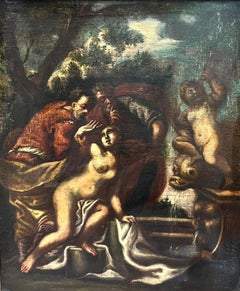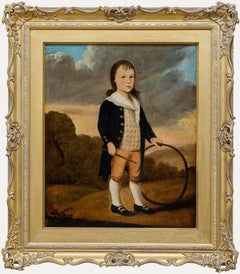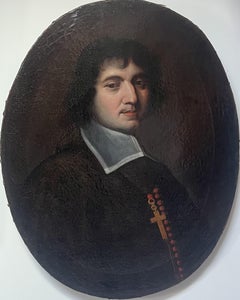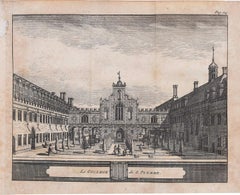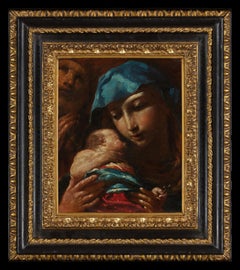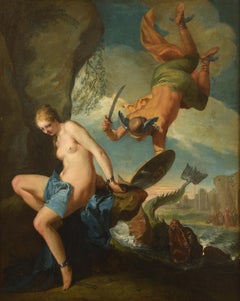Early 18th Century Art
to
169
249
104
59
46
34
Overall Width
to
Overall Height
to
7,504
21,240
158,682
233,807
1,958
2,279
4,869
6,412
5,802
13,175
19,500
25,558
18,192
13,734
5,360
122
62
1
257
227
309
180
118
90
88
78
49
44
36
36
35
27
26
25
25
24
24
18
15
14
188
179
155
98
82
69
40
10
9
8
194
168
354
117
Period: Early 18th Century
Large 1700 Italian Old Master Nude Bather with Classical Figures Water Fountain
Located in Cirencester, Gloucestershire
Italian School, circa 1700's
Classical figures in landscape
oil on canvas, framed
framed: 36 x 32 inches
canvas: 30 x 25 inches
provenance: private collection, UK
condition: very goo...
Category
Old Masters Early 18th Century Art
Materials
Oil, Canvas
English School 18th Century Oil - Boy with A Hoop
Located in Corsham, GB
This 18th century portrait depicts a young child in formal attire standing in a pastoral landscape, holding a hoop toy. The composition juxtaposes the subject's rigid pose and ornate...
Category
Early 18th Century Art
Materials
Oil
France early 18th Century, Portrait of a cleric, oil on canvas
Located in Paris, FR
French school early 18th Century
Portrait of a cleric,
oil on canvas
68 x 54 cm, oval
I recently had this painting cleaned and restored by a professional restorer. It is in good co...
Category
Old Masters Early 18th Century Art
Materials
Oil
Peterhouse College, Cambridge engraving Pieter van der Aa after David Loggan
Located in London, GB
Pieter van der Aa (1659 - 1733), after David Loggan (1634 - 1692)
Peterhouse College, Cambridge
Engraving
12 x 16 cm
An eighteenth-century view of Peterhouse College, Cambridge, eng...
Category
Realist Early 18th Century Art
Materials
Engraving
Holy Family, by the bolgonese master.
By Giuseppe Maria Crespi, Lo Spagnuolo
Located in New York, NY
This exquisite painting, resembling a precious jewel, serves as an exceptional illustration of the devotional cabinet paintings created by Giuseppe Maria Crespi, a highly original Bolognese artist during the late 17th and early 18th centuries. Crespi's distinctiveness extended beyond his unique style and technique to the subjects he chose to portray. While his portraits and genre paintings often displayed a light-hearted and even irreverent tone, his treatment of religious themes resonated with deep emotion, even in its most inventive forms.
This recently uncovered work by Crespi is a typical representation, invoking the tender
connection between mother and child, and the Child's destiny, all within a compact and intimate format. Executed on a small scale, the painting showcases Crespi's remarkable sensitivity and mastery of paint, especially evident in the expressive brushwork of the drapery.
The restrained and focused composition of the Holy Family allows for contemplation of the figures. Mary cradles the Christ child gently, seemingly presenting him to the viewer, her gaze
knowing as the infant holds a diminutive cross, symbolizing his future crucifixion. Joseph appears in the background, emerging from the left side of the frame, gazing upward with folded hands in prayer.
Individual motifs from this painting reappear in other works by Crespi, suggesting a synthesis of familiar elements into a vibrant composition. The artist's revisitation of designs throughout his career is evident, and this painting on copper likely belongs to a later period, reflecting stylistic ties to other works and Crespi's increased production of smaller devotional pieces.
Distinguished by its cool palette, bold coloration, and the expressive force of the artist's hand, this Holy Family painting...
Category
Baroque Early 18th Century Art
Materials
Copper
$30,400 Sale Price
27% Off
Perseus and Andromeda
Located in Paris, Île-de-France
Carle Vanloo (Nice 1705 – Paris 1765)
Perseus and Andromeda
Oil on canvas. H. 081; W. 065.
Alongside François Boucher (1703-1770) and Charles-Joseph Natoire (1700-1777), Carle Vanlo...
Category
Old Masters Early 18th Century Art
Materials
Canvas, Oil
$64,000 Sale Price
20% Off
Still Life of Flowers and fruit - Dutch Old Master c1700 floral art oil painting
Located in Hagley, England
This superb Dutch Old Master floral still life oil painting is attributed to circle of Simon Pietersz Verelst. Painted circa 1700 the compositio...
Category
Old Masters Early 18th Century Art
Materials
Oil
$7,557 Sale Price
20% Off
Antique Italian painter - 18th century figure painting
Located in Varmo, IT
Italian painter (18th century) - Chrono.
90.5 x 106 cm.
Antique oil painting on canvas, without frame (not signed).
Condition report: Lined canvas. Good state of conservation of t...
Category
Old Masters Early 18th Century Art
Materials
Canvas, Oil
$4,756 Sale Price
20% Off
Fine Early 1700's French Oil Elegant Figures Lady being Dressed Rococo Interior
Located in Cirencester, Gloucestershire
French School, circa 1720's
circle of Nicolas Lancret (1690-1743)
oil painting on canvas
15 x 23 inches
provenance: private collection, UK
Fine depic...
Category
Rococo Early 18th Century Art
Materials
Canvas, Oil
$4,188 Sale Price
30% Off
Celestial Music - Etching by C.N. Cochin the Elder - Early 18th Century
Located in Roma, IT
Celestial Music is an original black and white etching on cream-colored paper, realized by Charles-Nicolas Cochin the Elder (1688-1754), the well-known ...
Category
Old Masters Early 18th Century Art
Materials
Etching
Lemons "La parte interiore": An Early 18th C. Volckamer Hand-colored Engraving
Located in Alamo, CA
This is an early 18th century hand-colored copperplate engraving of the anatomy of lemons by Johann Christoph Volkhamer, entitled "La parte interiore del Cedro di fio e Sugo doppio" ...
Category
Naturalistic Early 18th Century Art
Materials
Engraving
Flowering Jasmine and Laurel Plants: A Besler Hand-colored Botanical Engraving
Located in Alamo, CA
This is a hand-colored copper-plate engraving entitled "Gelsiminum Catalonicum, Mairana Latifollia, Euphasiaramosa Pratensis Flore Albo, Euphasia Minus Ramosa Flore Excereruleo Purpurascente", depicting flowering Jasmine, Mountain Laurel...
Category
Academic Early 18th Century Art
Materials
Engraving
Escuela española (XVIII) - Óleo sobre tela - San Francisco de Asís
Located in Sant Celoni, ES
Como pueden apreciar, la obra no va firmada
Se presenta enmarcada la obra con un marco del siglo xix en madera estucada y policromada (el marco presenta algún leve descolche)
El es...
Category
Old Masters Early 18th Century Art
Materials
Oil
$1,712 Sale Price
20% Off
Salmon On The Riverbank, 19th Century by JOHN BUCKNELL RUSSELL (1819-1893)
Located in Blackwater, GB
Salmon On The Riverbank, 19th Century
by JOHN BUCKNELL RUSSELL (1819-1893) sales to $20,000
Large 19th Century English study of salmon on the riverbank, oil on canvas by John Bickn...
Category
Early 18th Century Art
Materials
Canvas, Oil
$2,760 Sale Price
30% Off
Sir. John Powell, Knight: Early 18th C. Engraved Portrait After William Sherwin
Located in Alamo, CA
This is an early 18th century portrait of Sir John Powell entitled "The Honorable Sr. John Powell, Knight. one of the Justices of her Majesties' Court of Common Pleas. Ano. D 1711". It was engraved and published by John King in London in 1711, after an earlier work by William Sherwin. The engraving depicts a bust length portrait of Powell wearing an elaborate fir-trimmed robe and collar. The portrait is encompassed in an ornate oval frame, sitting on a pedestal with an impressive coat-of-arms below.
This engraved portrait is printed on laid, chain-linked watermarked cream-colored paper The sheet measures 15.25" high and 11.38" wide. It is adhered to an archival thick card at the upper corners, There is a 1/8" tear at the lower edge of the sheet, but the print is otherwise in very good condition. This engraving is held by museums and institutions, including the British Museum and the Harvard University Art Museum.
Sir John Powell (1632-1696) was an English lawyer and judge who served as a justice of the King's Bench from 1683 until his death. He was born in Glamorganshire, Wales, and studied at Jesus College, Oxford, before being called to the bar at the Middle Temple in 1656. Powell was known for his staunch support of the monarchy and the Church of England, and he played a prominent role in the trial of the Whig leader Lord William Russell in 1683, which resulted in Russell's execution for his alleged involvement in a plot to assassinate King Charles II. Powell was also involved in the trials of several other prominent Whig politicians, including Algernon Sidney and Titus Oates. In addition to his work as a judge, Powell was also a member of Parliament for various constituencies throughout his career, and he served as Solicitor General and Attorney General for Wales under King James II. However, he opposed James's efforts to promote Catholicism and supported the Glorious Revolution of 1688, which led to James's overthrow and the installation of William and Mary as joint monarchs.
Powell was known for his intellectual rigor and his legal expertise, and he authored several influential legal treatises during his lifetime. He was widely respected by his peers and by the legal community as a whole, and his legacy as a jurist and judge continues to be celebrated today.
William Sherwin (1645-1709) was an English engraver who worked during the late 17th and early 18th centuries. He was born in Chesterfield, Derbyshire, and is known for his high-quality engravings of various subjects, including portraits, landscapes, and architectural views. Sherwin was trained as an engraver and worked as an apprentice to the renowned engraver Robert White. After completing his training, he went on to establish his own studio in London, where he produced a significant body of work over the course of his career. One of Sherwin's most famous works is his engraving of the portrait of John Locke...
Category
Old Masters Early 18th Century Art
Materials
Engraving
$620 Sale Price
20% Off
Escuela española (XVIII) - Óleo sobre tela - San Francisco de Asís
Located in Sant Celoni, ES
Como pueden apreciar, la obra no va firmada
Se presenta enmarcada la obra con un marco del siglo xix en madera estucada y policromada (el marco presenta algún leve descolche)
El es...
Category
Old Masters Early 18th Century Art
Materials
Oil
Manner of Francois Boucher - 18th Century Oil, Lovers in Autumn
Located in Corsham, GB
A romantic oil study depicting a couple resting on a woodland floor feeding each other fruit. The scene appears to be a play on the Four Seasons series by François Boucher where the...
Category
Early 18th Century Art
Materials
Oil
Two Arcadic Landscapes - J.F. Van Bloemen (follower of) - Oil on Canvas
Located in Roma, IT
Two Arcadic Landscapes are a couple of original oil paintings by a follower of the Flemish artist, Jan Frans Van Bloemen (1662-1749).
These old master's original paintings represen...
Category
Old Masters Early 18th Century Art
Materials
Oil
FINE 18th CENTURY OLD MASTER CHALK DRAWING - ROMANESQUE FIGURES INTERIOR SCENE
Located in Cirencester, Gloucestershire
Artist/ School: French School, 18th century
Title: Classical figures within an interior.
Medium: chalk on paper, mounted.
Size: drawing: 11.5 x 13.5 inches
Provenance:...
Category
Old Masters Early 18th Century Art
Materials
Chalk
17th Century Italian Old Master Oil Painting Moses Striking Water from the Rock
By Pier (Pietro) Dandini
Located in Cirencester, Gloucestershire
Moses Striking Water from the Rock;
Circle of Pietro Dandini, Italian 1646-1712
Italian School, late 17th century
oil on canvas, framed
framed: 3...
Category
Old Masters Early 18th Century Art
Materials
Canvas, Oil
$5,904 Sale Price
30% Off
Early-18th Century French School, Ex-Voto Portrait With Emilian Jacobin
Located in Cheltenham, GB
This splendid early 18th-century French oil painting represents an ‘ex-voto’ with Emilian Jacobin and a depiction of the Virgin Mary with Christ and angels.
Ex votos are votive offe...
Category
French School Early 18th Century Art
Materials
Canvas, Oil
Jean-Baptiste Oudry workshop (French Rococò) - 18th century Still Life painting
By Jean-Baptiste Oudry
Located in Varmo, IT
Jean-Baptiste Oudry (Paris 1686 - Beauvais 1755) circle of - Architecture with Still Life of Fruit.
59 x 97 cm unframed, 74 x 107.5 cm with frame.
Old oil painting on canvas, in a ...
Category
Rococo Early 18th Century Art
Materials
Canvas, Oil
Large 18th Century English Old Master Oil Painting Portrait of Lady on canvas
Located in Cirencester, Gloucestershire
Portrait of a Lady
English School, 18th century
oil on canvas, unframed
canvas : 31 x 25 inches
provenance: private collection, UK
condition: good and sound condition
Category
Old Masters Early 18th Century Art
Materials
Oil, Canvas
18th Century Oil - St Francis Xavier
Located in Corsham, GB
An evocative 18th-century oil depicting St Francis Xavier - the 16th-century Catholic missionary and co-founder of the Jesuit order. The artist has depicted the figure with elements ...
Category
Early 18th Century Art
Materials
Oil
Female Nude in Front of a Curtain with Clothes - Oil on Canvas - 18th Century
Located in Roma, IT
Female nude in front of a curtain with clothes is an old master artwork realized by an Italian artist in the early 18th century,
Mixed colored oil on canvas.
Good condition.
Category
Modern Early 18th Century Art
Materials
Oil
Pair of Roman Landscapes - by J.F. Van Bloemen - 18th Century
Located in Roma, IT
Beautiful couple of Roman Landscape by J. F. Van Bloemen, in very good conditions and with later wooden frames.
Bibliography and Exhibitions:
Old Master Exhibition, H.Terry-Engell, ...
Category
Early 18th Century Art
Materials
Oil, Canvas
H. Cromwell - 1797 Watercolour, The Ruins of Wolvesey Castle, Winchester
Located in Corsham, GB
Two figures stand amidst the ruins of Wolvesey Castle, framed by a crumbling arch. The artist employs careful, fine brushwork in this late eighteenth-century watercolour. Inscribed w...
Category
Early 18th Century Art
Materials
Watercolor
17th-18th Century By Matteo Bonechi Marine Triumph Oil on Canvas
Located in Milano, Lombardia
Matteo Bonechi (Florence, Italy, 1669 - 1756)
Title: Marine Triumph
Medium: Oil on canvas
Dimensions: without frame 65 x 80 cm - with frame 85 x 100 cm
Not signed
Expertise by Profe...
Category
Old Masters Early 18th Century Art
Materials
Canvas, Oil
Besler Hand-colored Botanical Engraving of Flowering Tulip & Wild Garlic Plants
Located in Alamo, CA
This is a hand-colored copperplate engraving entitled "Tulipa viridiscoloris, Fritillaria iuncifolns, Allium Vrsinum" depicting flowering tulip, fritillary and wild garlic plants fro...
Category
Academic Early 18th Century Art
Materials
Engraving
Flowering Hyacinth & Calla Plants: A Besler Hand-colored Botanical Engraving
Located in Alamo, CA
This is a hand-colored copper plate engraving depicting flowering "Hyacinthus Comosus Spurius" (Hyacinth), "Hyacinthus Anglicus" (Blue Hyacinth), "Palma ...
Category
Academic Early 18th Century Art
Materials
Engraving
New College, Oxford engraving by Pieter van der Aa after David Loggan
Located in London, GB
Pieter van der Aa (1659-1733), after David Loggan (1634–1692)
New College, Oxford
Engraving
12 x 16 cm
An eighteenth-century view of Le College Neuf (New College), engraved by Piete...
Category
Realist Early 18th Century Art
Materials
Engraving
18th c. French Portrait of a Lady as Venus, attributed to Pierre Gobert
By Pierre Gobert
Located in PARIS, FR
Portrait of a Lady as Venus
ATTRIBUTED TO PIERRE GOBERT (1662-1744)
FRENCH SCHOOL AROUND 1720
OIL ON CANVAS: H. 55.51 in, W. 42.91 in.
IMPORTANT 18TH CENTURY GILTWOOD FRAME (RE-GILT)...
Category
Old Masters Early 18th Century Art
Materials
Canvas, Oil
$32,342 Sale Price
20% Off
18th Century Oil - Bust of A Man in Red Cap
Located in Corsham, GB
A striking portrait featuring a figure in 17th-century dress. He sports a red cap and dark clothing against a shadowy background, masterfully capturing the subject's intense gaze and...
Category
Early 18th Century Art
Materials
Oil
The Bodleian Library, Oxford University by Pieter van der Aa after David Loggan
Located in London, GB
Pieter van der Aa (1659-1733), after David Loggan (1634–1692)
The Bodleian Library, Oxford
Engraving
12 x 16 cm
An eighteenth-century view of the bea...
Category
Realist Early 18th Century Art
Materials
Engraving
Naive 18th Century Oil - Mary and Child Appear Before Monks
Located in Corsham, GB
This religious painting depicts the Virgin Mary and Baby Jesus appearing in a heavenly vision above kneeling monks. The composition is framed by a floral wreath with cherubs dotted t...
Category
Early 18th Century Art
Materials
Oil
Thistle and Moths, plate no. 6, Metamorphosis Insectorum Surinamensium
Located in Middletown, NY
Metamorphosis Insectorum Surinamensium, Plate No. 6; Thistle and Moths. The Netherlands: 1705. Engraving with hand coloring in w...
Category
Naturalistic Early 18th Century Art
Materials
Watercolor, Engraving
Felice Boselli (Baroque) - 18th century figure painting - Still life Sheperds
By Felice Boselli
Located in Varmo, IT
Felice Boselli (Piacenza 1650 - Parma 1732) - Shepherd with flock and game.
155 x 112 cm without frame, 170 x 126 cm with frame.
Ancient oil painting on canvas, in a wooden frame lacquered in faux marble. The painting has stylistic affinities with "Game with children playing with a dog" (Parma, Galleria Nazionale) and with the pair of paintings "Old man and girl...
Category
Baroque Early 18th Century Art
Materials
Canvas, Oil
An Elegant Hawking Party, A Pair of Paintings
By August Querfurt
Located in Wiscasett, ME
A pair of old master paintings by August Querfurt (1696-1761). Oil on panel, one signed with initials in the lower left. Two scenes depicting hawking parties from the 18th century. I...
Category
Old Masters Early 18th Century Art
Materials
Oil
18th Century Oil on Canvas Biblical Italian Painting Judith and Holofernes
Located in Vicoforte, IT
Wonderful Italian painting from the first half of the 18th century. Oil on canvas artwork depicting a fascinating biblical story, the beheading of the Babylonian leader Holofernes by...
Category
Early 18th Century Art
Materials
Canvas, Oil
Bur Reed & Water Hemlock: A 17th-18th C. Besler Hand-colored Botanical Engraving
Located in Alamo, CA
This is a hand-colored copper plate engraving entitled "Orobanche, Cicuta Maxima, Sparganium (Bur Reed, Water Hemlock, Broomrape) ", depicting a flowering Bur Reed, Water Hemlock, Broomrape plants from Basilius Besler's landmark work, Hortus Eystettensis (Garden at Eichstatt), first published in 1613 in Eichstatt, Germany near Nuremberg and later in 1640 and 1713.
This beautiful colorful engraving is printed on thin laid chain-linked paper with wide margins. There us spotting and some discoloration, most prominently in the upper and lower margins. There is irregularity and some loss along the right paper edge. The print is otherwise in excellent condition with striking hand-coloring. The sheet measures 21.5" high and 17.25" wide.
Basilius Besler (1561–1629) was an apothecary and botanist. He was curator of the Willibaldsburg Castle garden of Johann Konrad von Gemmingen, prince bishop...
Category
Academic Early 18th Century Art
Materials
Engraving
Alessio de Marchis workshop (Italian baroque) - 18th century landscape painting
By Alessio de Marchis (Naples, 1684 - Perugia, 1752)
Located in Varmo, IT
Alessio de Marchis (Naples 1684 - Perugia or Urbino 1752) circle of - Arcadian Landscape with Shepherds and Flock.
60 x 72 cm unframed, 74 x 86 cm with frame.
Ancient oil painting ...
Category
Baroque Early 18th Century Art
Materials
Canvas, Oil
$1,426 Sale Price
40% Off
The Bloody Shouldered Arabian Horse Oil on canvas 18th Century
By John Wootton
Located in London, GB
John Wootton (1686 - 1764)
The Bloody-Shouldered Arabian
Oil on canvas
Inscribed below, 'Bred by Lord Oxford in 1755 & Sire of many famous Racers, including the Duke of Bolton's 'Swe...
Category
English School Early 18th Century Art
Materials
Oil
Ancient Roman Architecture: Original Framed 18th C. Etching by G. Piranesi
Located in Alamo, CA
"Veduta del Sepolcro della Famiglia Plauzia per la Strada Che Conduce da Roma a Tivoli vicino a Ponte Lugano" from "Le Antichità Romane" (Roman Antiquities), one of the most famous works by Piranesi. "Antichita" illustrates the tombs along the Appian Way...
Category
Old Masters Early 18th Century Art
Materials
Etching, Engraving, Drypoint
Chamomile & Safflower: A 17th-18th C. Besler Hand-colored Botanical Engraving
Located in Alamo, CA
This is a hand-colored copper plate engraving entitled "Chamemelum Romanum flore simplici (Chamomile), Cincus Sativus (False saffron, Safflower), Chamaemelum Romanum Flore (Roman Chamomile)", depicting flowering Chamomile, Safflower and Roman Chamomile plants respectively from Basilius Besler's landmark work, Hortus Eystettensis (Garden at Eichstatt), first published in 1613 in Eichstatt, Germany near Nuremberg and later in 1640 and 1713.
This beautiful colorful engraving is printed on thin laid chain-linked paper with wide margins. There are a few small spots and some irregularity of the lower edge. There is some bleed-through of text from the verso. The print is otherwise in excellent condition with striking hand-coloring. The sheet measures 22.25" high and 17.38" wide.
Basilius Besler (1561–1629) was an apothecary and botanist. He was curator of the Willibaldsburg Castle garden of Johann Konrad von Gemmingen, prince bishop...
Category
Academic Early 18th Century Art
Materials
Engraving
Anne Salmon - Fine 1791 Embroidery, The Cheerful Voyagers
Located in Corsham, GB
An exceptionally fine Georgian embroidery by Anne Salmon depicting 'Cheerful Voyagers' punting in the serene English countryside. Executed with rem...
Category
Early 18th Century Art
Materials
Tapestry
18th century oil painting English portrait of a gent in armor, wearing a wig
By studio of Sir Godfrey Kneller
Located in Woodbury, CT
Outstanding early 18th century English portrait of James Bellevue.
The portrait was always believed to be the work of Sir Godfrey Kneller who was known to have painted James Bellevu...
Category
Old Masters Early 18th Century Art
Materials
Canvas, Oil
18th century portrait of the artist’s daughter, Catharina, playing the cello
By Balthasar Denner
Located in Bath, Somerset
The sitter, seated in a yellow silk gown trimmed with a pink bow playing the cello, is believed to be the artist Balthazar Denner's eldest daughter Catharina (1715-1744), after his marriage to Esther Winter in Hamburg in 1712. She is also recognisable in another portrait of the Denner family in the Hamburg Kunsthalle, painted circa 1740 by the artist's son, Jacob Denner (1722-1765). Oil on canvas in a period giltwood frame.
Provenance: Private collection, Northern Germany
Professor Helmut Borsch-Supan, Berlin, confirmed the authenticity of the painting after examining it in 2013. The painting will also be included in the forthcoming catalogue raisonnée of the artist, by Ute Mannhardt.
Balthasar Denner...
Category
Old Masters Early 18th Century Art
Materials
Canvas, Oil
Framed 18th Century Pen and Ink Drawings - Designs for Capital & Base Supports
Located in Corsham, GB
Framed 18th-century pen and ink drawings of elaborate capital and base supports, inspired by Ancient Greek architecture and design. Well presented in a fluted gilt-effect frame. Unsi...
Category
Early 18th Century Art
Materials
Pen
Circle of Michael Dahl (1659-1743) - Early 18th Century Oil, Lady with Jasmine
By Michael Dahl
Located in Corsham, GB
This formal portrait depicts a woman in early 18th-century dress, wearing an elegant dark gown with white lace trim and a red drape or shawl. She holds jasmine flowers in her hand, s...
Category
Early 18th Century Art
Materials
Oil
Fine 18th Century Oil - Portrait of a Lady in Pearls
Located in Corsham, GB
A delightfully elegant 18th-century tondo depicting a lady in pearls. The subject is rendered in exquisite detail and is captured in fine attire, typical of the Georgian period. Beau...
Category
Early 18th Century Art
Materials
Oil
Manner of Francois Boucher (1703-1770) - Pastel, A Moment of Romance
Located in Corsham, GB
A romantic late 18th century pastel rendered in the manner of Francois Boucher (1703-1770), portraying two lovers tenderly embracing in a moonlit forest. Beside them, their loyal dog...
Category
Early 18th Century Art
Materials
Pastel
Spanish School 18th Century Oil - The Crown
Located in Corsham, GB
This richly detailed 18th-century still life depicts symbols of royal authority and power, featuring an ornate golden crown alongside armour, a ceremonial key and a cannon ball on a ...
Category
Early 18th Century Art
Materials
Oil
North and South America: An 18th Century Hand-colored Map by Johann Homann
Located in Alamo, CA
This early 18th century hand-colored copperplate map of North and South America entitled "Totius Americae Septentrionalis Et Meridionalis Novissima Repraesentatio" was created by Johann Baptist Homann and published in Nuremberg, Germany, between 1710 and 1731. The map details cities, forts, mountains, forests and lakes, as well as districts. There is a decorative cartouche in the lower left which depicts a volcano, scenes representing the people in their native costumes, as well as animals and plants of the Americas. A village is seen in the background on the left. A second smaller decorative cartouche in the upper right includes text and a series of allegorical figures. A large portion if the north central and western portions of North America is left without detail, because the region was largely unexplored at the time this map was created. The map also shows "Terra Esonis Incognita", representing a mythical continuous land bridge from North America to Asia, a northwest passage. The map preceded the French and...
Category
Old Masters Early 18th Century Art
Materials
Engraving
New Map of the Terraqueous Globe - WORLD MAP - CALIFORNIA AS AN ISLAND
By Edward Wells
Located in Santa Monica, CA
EDWARD WELLS (British 1667- 1727)
A NEW MAP of the TERRAQUEOUS GLOBE - according to the latest Discoveries and most general Divisions of it into CONTINENTS and OCEANS, 1700-01 (Shirley 609)
Engraved by Michael Burghers, Oxford. Hand-colored, Platemark 14 1/4 x 20 1/8 inches. Central cartouche flanked by figures representing the continents with dedication to William, Duke of Gloucester...
Category
Old Masters Early 18th Century Art
Materials
Engraving
Escuela española (XVIII) - Óleo sobre cobre - Virgen orando
Located in Sant Celoni, ES
La pintura representa a la Virgen María por su iconografía tradicional. Viste un manto azul verdoso que cubre su cabeza y hombros, y una túnica rosada con detalles en tonos claros. S...
Category
Old Masters Early 18th Century Art
Materials
Oil
Willem van Kessel (c.1691–1727) – Portrait of Bewigged Gentleman in Armour, 1713
Located in Holywell, GB
Willem van Kessel (c.1691–1727) – Portrait of a Bewigged Gentleman in Armour, 1713
A highly decorative and striking oil painting depicting a bewigged gentleman clad in a suit of arm...
Category
Flemish School Early 18th Century Art
Materials
Oil
Madonna and Child- Italian Old Master religious art portrait oil painting
Located in Hagley, England
This superb Italian Old Master religious portrait oil painting is attributed to circle of Bartolomeo Schedoni. Painted circa 1700 it is a half l...
Category
Old Masters Early 18th Century Art
Materials
Oil
$6,309 Sale Price
20% Off
Presumed portrait of Marie-Anne de Bourbon
Located in BELEYMAS, FR
Nicolas de LARGILLIERRE
(Paris 1656 – 1746)
Portrait of a woman, presumed to be Marie-Anne de Bourbon, Princess of Conti (1666-1739)
Oil on oval canvas
H. 8...
Category
French School Early 18th Century Art
Materials
Canvas, Oil
Outstanding 18' century Paintings The Wedding Feast of Bacchus and Ariadne
Located in Rome, IT
Pair of large painting oil on canvas with the Wedding Feast of Bacchus and Ariadne scene .
Italy 18' century .
Amazing landscape background and roman Temple with classical archite...
Category
Old Masters Early 18th Century Art
Materials
Oil
A Portrait of a Bewigged Gentleman
By Enoch Seeman
Located in St. Albans, GB
Enoch Seeman
Canvas Size: 30 x 25" (76 x 62cm)
Outside Frame Size: 37 x 32" (92 x 80cm)
1694-1744
He was born in Danzig, now Gdansk, Poland, around 1694. His father, also Enoch...
Category
Old Masters Early 18th Century Art
Materials
Oil
